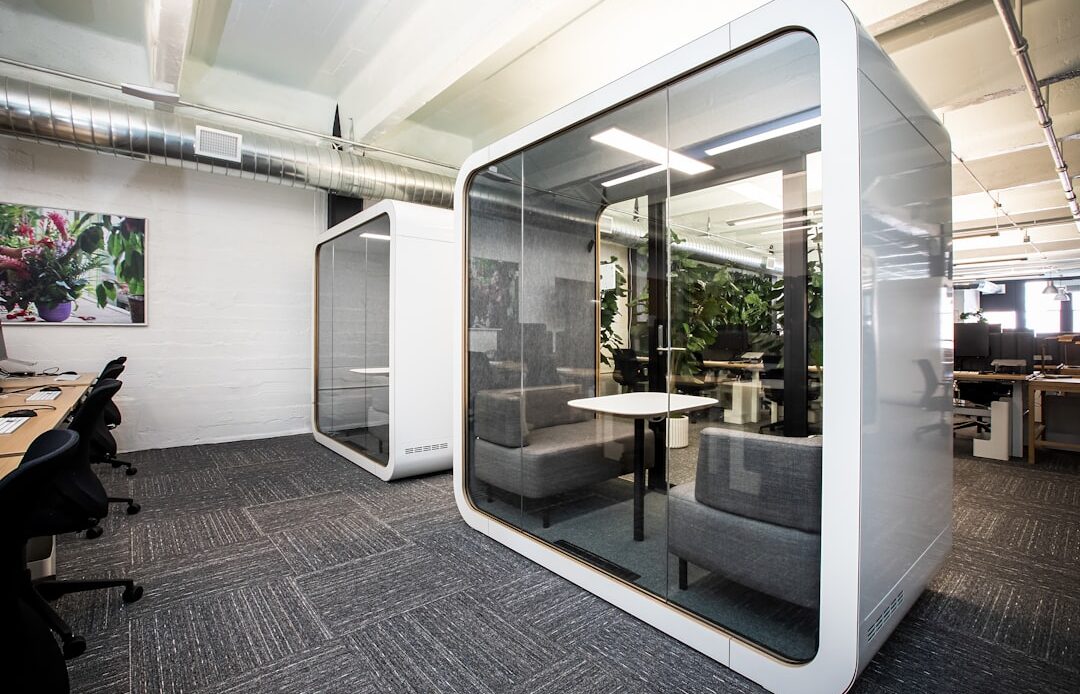
In recent years, the landscape of office design has undergone a significant transformation, reflecting the evolving needs of the workforce and the demands of modern business practices. Gone are the days of rigid cubicles and uninspiring environments; today’s offices are characterized by open spaces, innovative layouts, and a focus on employee well-being. This shift is not merely aesthetic; it is rooted in a deeper understanding of how physical environments influence productivity, creativity, and overall job satisfaction.
As organizations strive to attract and retain top talent, the design of their workspaces has become a critical factor in fostering a positive corporate culture. Modern office design encompasses a variety of elements that prioritize flexibility, collaboration, and comfort. It integrates technology seamlessly into the workspace while also considering the psychological and physical needs of employees.
By creating environments that are not only functional but also inspiring, companies can enhance employee engagement and drive performance. This article will explore the multifaceted benefits of modern office design, examining how it can lead to increased productivity, improved employee well-being, and a more sustainable future for workplaces.
The Benefits of Modern Office Design for Productivity
The impact of modern office design on productivity cannot be overstated. Research has shown that well-designed workspaces can significantly enhance employee output by creating an environment that fosters focus and creativity. For instance, open floor plans encourage communication and collaboration among team members, breaking down silos that often hinder innovation.
When employees feel connected to their colleagues, they are more likely to share ideas and work together effectively, leading to improved problem-solving and project outcomes. Moreover, modern office design often incorporates elements that reduce stress and promote well-being. Features such as comfortable seating, vibrant colors, and thoughtful layouts can create a more inviting atmosphere that motivates employees to perform at their best.
By prioritizing aesthetics alongside functionality, organizations can cultivate a sense of pride in their workspace, which in turn boosts morale and productivity. Ultimately, investing in modern office design is not just about creating a visually appealing environment; it is about fostering a culture of excellence that empowers employees to thrive.
Incorporating Flexible Workspaces for Increased Efficiency
Flexibility is a cornerstone of modern office design, allowing organizations to adapt to the diverse needs of their workforce. The traditional model of fixed desks and assigned seating is being replaced by dynamic workspaces that accommodate various working styles. This shift enables employees to choose where and how they work best, whether it be in collaborative areas, quiet zones, or even informal lounges.
Such adaptability not only enhances individual productivity but also promotes a sense of ownership over one’s work environment. Incorporating flexible workspaces can lead to increased efficiency as teams can easily reconfigure their surroundings based on project requirements or personal preferences. For example, during brainstorming sessions, employees may prefer open areas that encourage dialogue and creativity.
Conversely, when focused work is needed, they might gravitate towards quieter spaces designed for concentration. By providing a range of options, organizations empower their employees to tailor their work experience, ultimately leading to higher levels of satisfaction and output.
Utilizing Natural Light and Biophilic Design for a Healthier Work Environment
The integration of natural light into office design has been shown to have profound effects on employee health and productivity. Exposure to natural light helps regulate circadian rhythms, improving sleep quality and overall well-being. Furthermore, it has been linked to increased energy levels and enhanced mood, which can significantly impact workplace performance.
Modern office designs often feature large windows, skylights, and open layouts that maximize daylight exposure, creating a more inviting atmosphere. Biophilic design takes this concept a step further by incorporating elements of nature into the workspace. This approach recognizes the innate human connection to nature and seeks to bring the outdoors inside through plants, natural materials, and organic shapes.
Research indicates that biophilic design can reduce stress levels, enhance creativity, and improve cognitive function. By creating environments that reflect natural ecosystems, organizations can foster a sense of tranquility and inspiration among employees, ultimately leading to a healthier and more productive workplace.
Implementing Technology and Ergonomic Furniture for Comfort and Functionality
In the age of digital transformation, technology plays a pivotal role in modern office design. The integration of advanced tools and systems not only enhances communication but also streamlines workflows. Smart technology solutions such as automated lighting, temperature control, and collaborative software can create a more efficient work environment that adapts to the needs of employees.
By leveraging technology effectively, organizations can optimize their operations while providing employees with the resources they need to succeed. Equally important is the incorporation of ergonomic furniture into office design. Ergonomics focuses on creating workspaces that promote comfort and reduce the risk of injury.
When employees are comfortable in their work environment, they are less likely to experience fatigue or discomfort, allowing them to maintain focus and productivity throughout the day. By prioritizing both technology and ergonomics in office design, organizations can create spaces that support both functionality and employee health.
Creating Collaborative Spaces to Encourage Teamwork and Innovation
Collaboration is at the heart of many successful organizations, making it essential for modern office designs to facilitate teamwork. Dedicated collaborative spaces—such as meeting rooms, brainstorming areas, and informal lounges—encourage employees to come together to share ideas and solve problems collectively. These spaces are often designed with flexibility in mind, allowing teams to rearrange furniture or utilize technology as needed for presentations or discussions.
Moreover, fostering a culture of collaboration can lead to increased innovation within an organization. When employees feel comfortable sharing their thoughts in an open environment, they are more likely to contribute unique perspectives that drive creative solutions. Modern office designs often incorporate elements such as writable walls or interactive displays that further enhance collaboration by providing tools for visual brainstorming and idea sharing.
By prioritizing collaborative spaces in office design, organizations can cultivate an atmosphere where teamwork thrives and innovation flourishes.
Reducing Distractions and Noise with Strategic Layout and Acoustics
While collaboration is vital for productivity, it is equally important to address distractions that can hinder focus. Modern office designs often incorporate strategic layouts that minimize noise pollution and create designated quiet areas for concentrated work. By thoughtfully arranging workstations away from high-traffic zones or utilizing sound-absorbing materials in construction, organizations can create environments conducive to focus.
Acoustic considerations are particularly important in open office settings where noise levels can fluctuate significantly throughout the day. Implementing soundproofing solutions such as acoustic panels or carpets can help mitigate distractions caused by conversations or electronic devices. Additionally, providing employees with access to quiet rooms or phone booths allows them to escape the hustle and bustle when they need uninterrupted time for deep work.
By prioritizing acoustics in office design, organizations can strike a balance between collaboration and concentration.
Promoting Employee Well-being with Wellness Rooms and Relaxation Areas
Recognizing the importance of mental health in the workplace has led many organizations to incorporate wellness rooms and relaxation areas into their office designs. These dedicated spaces provide employees with a sanctuary where they can recharge during busy workdays. Whether it’s a quiet room for meditation or a lounge area with comfortable seating for informal gatherings, these spaces promote relaxation and stress relief.
Wellness rooms often include features such as soft lighting, calming colors, and access to nature through plants or views of outdoor spaces. By creating environments that prioritize mental well-being, organizations demonstrate their commitment to supporting employees’ holistic health. Furthermore, research indicates that when employees have access to relaxation areas, they are more likely to return to their tasks feeling refreshed and focused.
This investment in employee well-being ultimately contributes to higher levels of engagement and productivity.
Embracing Sustainable and Eco-Friendly Design for a Greener Workplace
As environmental concerns continue to rise globally, many organizations are embracing sustainable design practices in their office spaces. Eco-friendly materials, energy-efficient systems, and waste reduction strategies are becoming integral components of modern office design. By prioritizing sustainability, organizations not only reduce their carbon footprint but also appeal to environmentally conscious employees who value corporate responsibility.
Sustainable design can manifest in various ways—from using recycled materials in construction to implementing energy-efficient lighting systems that reduce electricity consumption. Additionally, incorporating green spaces within office environments—such as rooftop gardens or indoor plants—can enhance air quality while providing employees with a connection to nature. By embracing sustainable practices in office design, organizations contribute positively to the environment while fostering a culture of responsibility among their workforce.
Maximizing Space Efficiency with Smart Storage Solutions and Multi-functional Areas
In an era where real estate costs continue to rise, maximizing space efficiency has become paramount for many organizations.
Built-in shelving units, modular furniture with hidden storage compartments, and shared storage areas can all contribute to a more organized environment.
Additionally, multi-functional areas allow organizations to make the most of their available space by serving various purposes throughout the day. For instance, a conference room may double as a training space or an informal meeting area when not in use for formal gatherings. This flexibility not only optimizes space but also encourages employees to utilize different areas based on their needs throughout the day.
By prioritizing space efficiency in office design, organizations can create functional environments that adapt seamlessly to changing demands.
The Impact of Modern Office Design on Productivity and Employee Satisfaction
The evolution of modern office design reflects a growing understanding of how physical environments influence employee productivity and satisfaction. By prioritizing elements such as flexibility, collaboration, natural light, technology integration, wellness spaces, sustainability, acoustics, and space efficiency, organizations can create workplaces that empower employees to thrive both personally and professionally. As businesses continue to adapt to changing workforce dynamics and expectations, investing in thoughtful office design will remain crucial for attracting top talent and fostering innovation.
Ultimately, modern office design is not just about aesthetics; it is about creating environments that inspire creativity while promoting well-being—a combination that leads to enhanced productivity and overall employee satisfaction in today’s fast-paced world.
